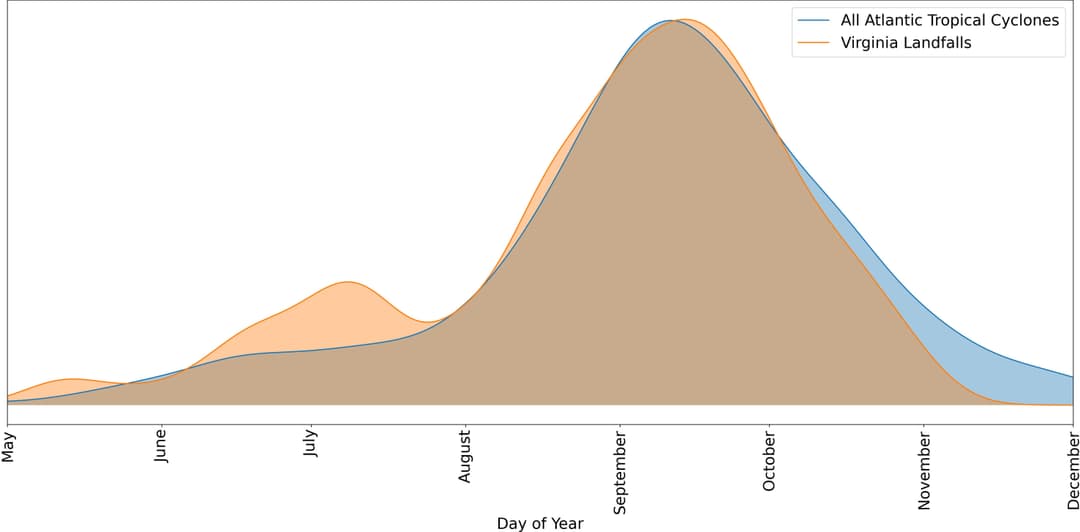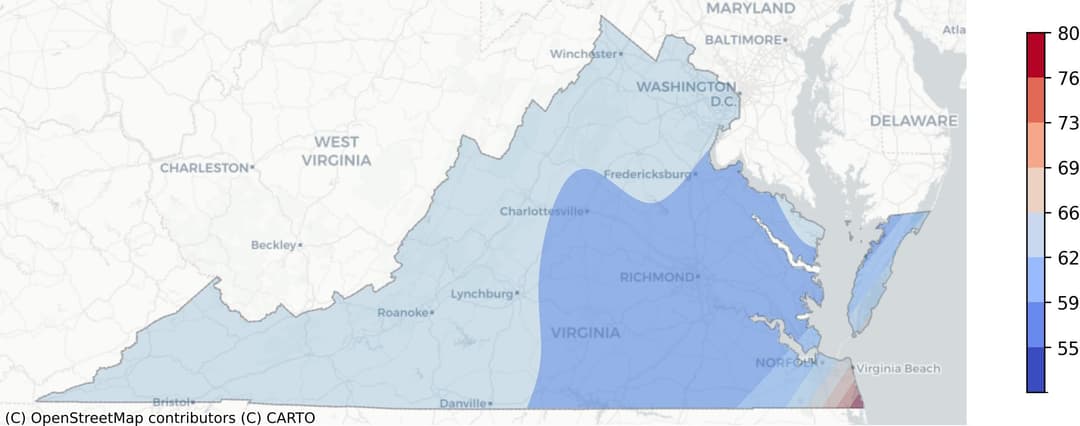Hurricanes in Virginia
When is Hurricane Season in Virginia?
The official hurricane season in Virginia spans from June 1st to November 30th, aligning with the Atlantic hurricane season. Some storms weaken to a tropical depression and move northeast, tracking along the Appalachian Mountains through western Virginia, then continue northeast and offshore the Appalachian Mountains.
According to the National Hurricane Center, Virginia experiences hurricanes, albeit fewer than states located further south along the Atlantic coastline.

A review of historical data provides valuable insights into Virginia's susceptibility to tropical cyclones. Drawing from hurricane paths since 1851, the image depicts the likelihood of Virginia experiencing a tropical cyclone on any given day of the year. It contrasts the storm landfalls in Virginia with patterns observed across the entire Atlantic basin. This data is sourced from the NOAA Hurricane Research division.
Where Do Hurricanes Hit Most in Virginia?
Virginia, located on the East Coast of the United States, is susceptible to the impacts of hurricanes, including storm surges, floods, and hurricane-force winds. The regions most frequently hit by hurricanes in Virginia are the Tidewater region and the Eastern Shore.
The Tidewater region, comprising the low-lying areas along the coast and the eastern part of the state, is especially vulnerable due to its proximity to the Atlantic Ocean. The region includes major cities like Norfolk, Virginia Beach, and Newport News. The geographical location and the flat topography of the Tidewater region make it susceptible to flood and storm surges brought on by hurricanes. A low-lying Coastal Plain spans the eastern seaboard of the United States from New Jersey to Georgia, extending westward from the Atlantic Ocean, according to Virginia History.
The Eastern Shore, a 70-mile-long peninsula separating the Chesapeake Bay from the Atlantic Ocean, is another region in Virginia that frequently experiences hurricanes, as mentioned by the National Weather Service. The Eastern Shore's exposure to the Atlantic Ocean makes it particularly vulnerable to hurricane-force winds, according to the Accomack-Northampton Planning District Commission.

The provided graph represents a hurricane risk heatmap for Virginia. The frequency of hurricanes, weighted by wind speed, is represented by a color gradient from blue to red. Areas depicted in red are the regions most susceptible to hurricanes, predominantly located in the Tidewater region and the Eastern Shore. These regions experience a higher frequency of hurricanes and bear the brunt of the associated high wind speeds. The color transition from blue to red, moving from west to east, demonstrates the increasing risk of hurricanes toward the coast. This visual representation underscores the susceptibility of Virginia's coastal regions to the devastating effects of hurricanes.
What Are the Recent Hurricanes in Virginia?
- Hurricane Dorian (September 2019): Despite not making direct landfall, the hurricane brought strong winds and rain to the coastal areas of Virginia. Economic losses amounted to $1.2 billion, but there were no fatalities reported. The hardest hit localities were Virginia Beach, Norfolk, and Hampton.
- Hurricane Florence (September 2018): The storm caused significant rainfall and flash flooding across the state. The total economic damage was estimated at $45 billion, with 1 death reported in Virginia. The most affected localities included Richmond, Newport News, and Lynchburg.
- Hurricane Matthew (October 2016): Matthew caused severe flooding in several parts of Virginia, leading to an estimated $10 billion in damages. The death toll in the state was 5. The hardest hit areas were Hampton Roads, Virginia Beach, and Norfolk.
- Hurricane Joaquin (October 2015): Though it did not make landfall, the storm resulted in heavy rainfall and flooding. The economic impact was around $200 million, with no lives lost in Virginia. The most affected localities were the coastal areas, including Virginia Beach and Norfolk.
- Hurricane Sandy (October 2012): Sandy's effects were felt throughout Virginia, with flooding, downed trees, and power outages. Economic losses in the state were estimated at $2 billion, with two fatalities. The hardest hit areas were Northern Virginia, Richmond, and Virginia Beach.
How to Prepare for a Hurricane Season in Virginia
The importance of preparing for a storm, particularly during the hurricane season in Virginia, cannot be overstated. It's not just about safeguarding personal property; it's also about ensuring the safety and well-being of families and communities. Prior preparation can significantly reduce the risks associated with hurricanes, minimizing the impact of such natural disasters. By taking proactive steps, individuals can increase their resilience to hurricanes and improve their recovery outcomes should such an event occur.
Before a Hurricane
When discussing hurricane preparedness in Virginia, there are several key steps that need to be taken to ensure safety. It's crucial to be proactive and not wait until a hurricane is imminent to start preparations. Here is a short list of essential tasks for a hurricane preparation checklist in Virginia:
- Develop an Emergency Plan: Identify evacuation routes and establish meeting points with your family. Make sure everyone understands the plan.
- Build an Emergency Kit: This should include water, food, medication, important documents, cash, and other essentials that would be necessary during a power outage or if you had to leave your home.
- Secure Your Home: Reinforce doors, windows, and any other vulnerable points in your house. Clear your yard of any loose items that could become projectiles in high winds.
- Stay Informed: Monitor the local news and weather forecasts closely. Follow the advice of local officials and evacuate if instructed to do so.
- Get Insurance: Make sure your insurance policies cover flood damage, a common occurrence during hurricanes.
In the face of a hurricane, the importance of hurricane safety in Virginia cannot be overstated. By adhering to these steps, residents can significantly increase their chances of weathering the storm safely.
During a Hurricane
Knowing what to do during a hurricane is vital for ensuring safety and minimizing potential damage. Here is a short list of recommended actions:
- Stay informed: Keep track of the hurricane's progress and updates from local authorities. Use a battery-operated radio if power is out.
- Stay indoors: Unless instructed to evacuate, it's safest to remain inside your home or shelter.
- Avoid windows: Hurricanes can cause dangerous flying debris. Stay in a room without windows or cover them with plywood from the outside.
- Secure your home: If you have time before the storm hits, secure loose objects outside your house that could become projectiles.
- Prepare a survival kit: This should include food, water, medication, and essential supplies for at least three days.
- Have a plan: Know your evacuation routes and have a predetermined location to meet up with family members.
After a Hurricane
Following a hurricane, it's crucial to take certain steps to ensure safety and facilitate recovery. Here is a brief list of actions to consider:
- Check the immediate surroundings for any hazards, such as fallen power lines, gas leaks, or damaged structures.
- Contact family members and inform them about your situation.
- Document any property damage with photographs or videos for future reference, especially for filing insurance claims.
- If your vehicle has been damaged, start the process for a car insurance claim.
- Contact your insurance company to report damages and start the claim process. Keep all receipts related to repairs, temporary lodging, and other related expenses.
- Register for disaster assistance from the Federal Emergency Management Agency (FEMA) if you're in a federally declared disaster area.
- Start cleaning and repairs as soon as it's safe to do so, always keeping safety in mind.
Each step plays a crucial role in the recovery process, helping to return to normal life as quickly as possible after a hurricane.